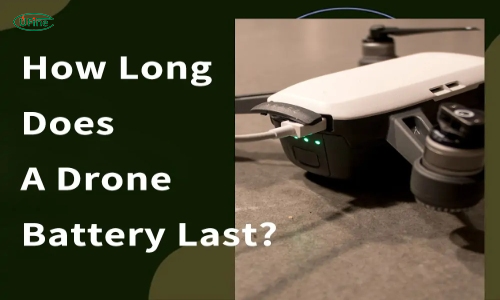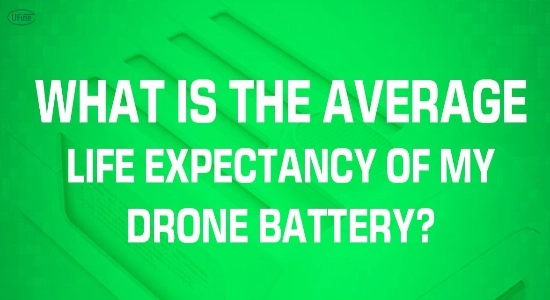Have you ever wondered how long a drone battery can last? This article explores drone battery life, covering factors that influence it, the average lifespan of drone batteries, and tips to make your drone battery last longer. Understanding these aspects can help drone enthusiasts maximize their flying time and enjoyment.
Part 1. Factors affecting drone battery life
Drone battery life can vary significantly based on several key factors.
Battery Capacity:
The battery’s capacity, measured in milliampere-hours (mAh), directly affects how long the drone can stay airborne. Higher capacity batteries typically offer longer flight times.
Battery Type:
Different types of batteries, such as lithium-ion (Li-ion) and lithium-polymer (LiPo), have varying energy densities and discharge characteristics. Drone enthusiasts commonly use LiPo batteries in drones because they are lightweight and have high discharge rates.
Drone Weight:
Heavier drones require more power to stay aloft, leading to shorter flight times than lighter models. Minimizing the weight of your drone through material choices and component selection can help extend battery life.
Flight Conditions:
Environmental factors such as temperature and wind speed can significantly impact battery performance. Cold weather reduces battery efficiency, while strong winds force the drone to work harder, draining the battery faster.
Flight Style:
Aggressive flying maneuvers like rapid acceleration, high-speed flights, and frequent changes in altitude consume more battery power than gentle, steady flights. Adjusting your flying style can help conserve battery life.
Maintenance:
Regular maintenance of your drone and its battery is crucial. Ensuring proper storage, avoiding overcharging, and keeping the battery terminals clean can extend its lifespan and overall performance.
Age of the Battery:
As batteries age, their capacity and performance degrade. Replacing old batteries with fresh ones or adequately managing the lifecycle of your batteries is essential for consistent flight performance.
Part 2. The average lifespan of drone batteries
Lithium Polymer (LiPo) Batteries
LiPo batteries are the most commonly used type in drones due to their high energy density and lightweight nature. Here’s what you need to know about their lifespan:
- Typical Lifespan: LiPo batteries generally last between 150 to 300 charge cycles under optimal conditions. This translates to approximately 1 to 2 years of regular use, depending on factors like usage patterns and maintenance.
Factors Influencing Lifespan:
- Charge and Discharge Rates: High discharge rates and frequent deep discharges can shorten the lifespan of LiPo batteries.
- Storage Conditions: Proper storage at around 50% charge and room temperature helps prolong battery life.
- Physical Damage: Impacts or punctures can compromise the battery’s integrity and shorten its lifespan.
- Age: As LiPo batteries age, their internal resistance increases, leading to reduced capacity and shorter flight times.
Other Battery Types
While LiPo batteries dominate the drone market, drone enthusiasts also use other battery chemistries, each with different characteristics and lifespans:
Overview of Other Battery Chemistries:
- Lithium-Ion (Li-ion): Li-ion batteries offer a longer lifespan than LiPo, typically lasting 300 to 500 charge cycles. They are heavier but more stable and safer.
- Nickel-Cadmium (NiCd): Rarely used due to environmental concerns and lower energy density. Lifespan is around 500 charge cycles.
- Nickel-Metal Hydride (NiMH): Also less common in drones, with a lifespan similar to NiCd batteries.
Comparison of Lifespan:
LiPo batteries generally have a shorter lifespan than Li-ion batteries but offer higher discharge rates and are lighter, making them ideal for drones where weight and power output are critical factors.
Li-ion batteries are heavier but offer better longevity and stability, making them suitable for applications requiring longer flight times and less frequent battery replacements.
Part 3. Tips to extend drone battery life
Pre-flight Preparation
Taking care of your drone battery before you fly can significantly affect its lifespan.
Battery Maintenance Practices:
- Regular Inspections: Check for any signs of damage or swelling. Replace damaged batteries immediately to prevent failures.
- Balancing Cells: Use a balance charger to charge all cells evenly. This helps maintain battery health and performance.
Importance of Proper Charging Techniques:
- Use the Right Charger: Always use the charger designed for your battery type to avoid overcharging or undercharging.
- Avoid Overcharging: Disconnect the battery once it’s fully charged. Overcharging can lead to overheating and reduce battery life.
- Charge at Room Temperature: Charge batteries in a cool, dry place. Avoid charging in extreme temperatures.
In-flight Practices
How you fly your drone can significantly affect how long the battery lasts during and after each flight.
Optimizing Flight Settings for Longer Battery Life:
- Use Low Power Mode: Some drones have an eco or low power mode. Use these settings to extend flight time.
- Limit Payload: Reduce the weight your drone carries. Extra weight requires more power, draining the battery faster.
Best Practices During Flight to Conserve Battery:
- Smooth Flying: Avoid sudden accelerations and sharp turns. Soft, steady flying uses less power.
- Monitor Battery Levels: Keep an eye on battery levels and land before the battery gets too low. This prevents deep discharges, which can damage the battery.
- Avoid Extreme Conditions: Don’t fly in very windy or cold weather. These conditions force the drone to work harder, using more battery power.
Post-flight Care
Taking care of your battery after flying is as important as before and during the flight.
Cooling Down Batteries After Use:
- Allow to Cool: Let the batteries cool to room temperature before charging or storing them. Charging a hot battery can damage it.
- Avoid Immediate Recharges: Wait at least 20-30 minutes before recharging a used battery to ensure it has cooled down completely.
Storage Recommendations for Prolonging Battery Life:
- Store at 50% Charge: Batteries should be stored at about 50% if you’re not using them for a while. This helps prevent degradation.
- Keep in a Cool, Dry Place: Store batteries in an excellent, dry location. Avoid places with high humidity or extreme temperatures.
- Periodic Checks: If storing for an extended period, check the battery’s charge level every few months and recharge to 50% if needed.
Part 4. FAQs
-
How long does it take to charge a drone battery?
Charging a standard LiPo drone battery typically takes 60 to 90 minutes, with high-capacity batteries potentially requiring longer. -
What should I do if my drone battery gets wet?
Turn off and disconnect the battery immediately. Dry thoroughly and place it in a container of uncooked rice or silica gel packs for 24-48 hours. Check for damage before using it again. -
How can I safely dispose of old drone batteries?
Take old batteries to a battery recycling facility or electronic waste center. Cover the terminals with tape before disposal. -
Is it safe to leave my drone battery charging overnight?
No, it’s not safe. Overcharging can cause overheating and damage the battery. Continuously monitor the charging process and disconnect when fully charged.
Related Tags:
More Articles

LiPo Battery Discharge Rate Guide & Calculation Tips
Understand LiPo battery discharge rates, C-ratings, and how to calculate max current. Essential guide for RC, drones, and electronics users.
High‑Capacity 3S LiPo Batteries: 5000 mAh vs. 10000 mAh
Compare 3S LiPo 5000mAh vs 10000mAh batteries by weight, power, and use. Find the best fit for your drone, RC car, or boat setup.
Top 5 Applications for Small 3S LiPo Batteries
Small 3S LiPo batteries power drones, RC gear, wearables, and robotics with high energy and low weight. Making them ideal for compact electronics projects.
Building and Charging Your Own 3S LiPo Pack: A Step‑by‑Step Guide
Learn how to build, balance, and charge a 3S LiPo battery pack safely at home with this complete DIY guide for hobbyists and beginners.
How to Choose the Right LiPo Battery Plug Type?
Discover the best LiPo battery plug types, how to choose them, and expert tips for safe usage, soldering, and maintenance.






